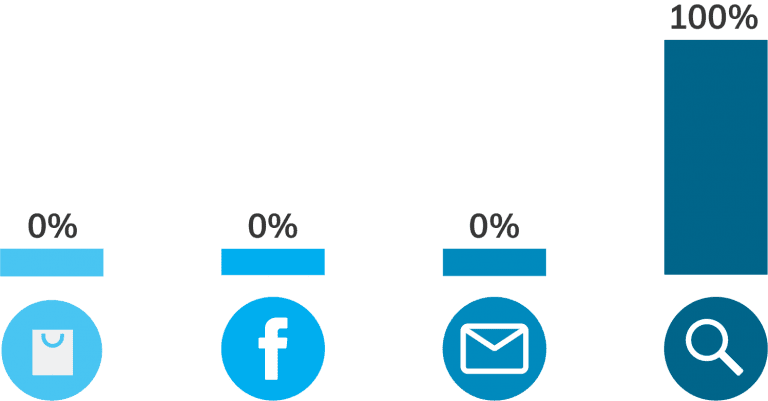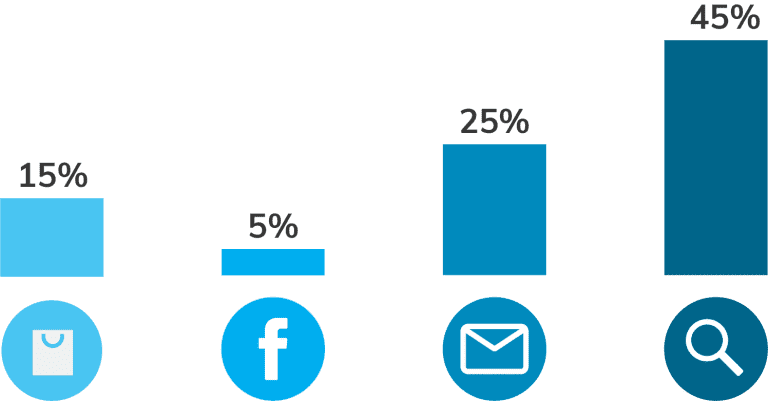When it comes to measuring performance for your digital marketing campaigns, there are several attribution models to choose from. Here at Omnitail, we see benefit in utilizing a combination of two: last click attribution and assisted conversion data.
Perhaps the most commonly used of the two, last click attribution, gives credit to the channel receiving the last-click before a conversion takes place. Makes sense to apply this type of model, right? Sure, but it doesn’t provide the full scope that an assisted attribution model will. Let’s dive into the benefits of using assisted conversion data.
Don’t have time to read the blog? Get the basics in this quick video:

What is an Assisted Conversion?

Last Click Attribution: Only the last channel gets credit for the sale. In our example, even though the shopper interacted with Google Shopping, Paid Social, and Email advertisements, only Organic gets credit.

Assisted Attribution: All the channels the user interacted with get some credit for the sale. Now, Google Shopping, Paid Social, and Email advertisements get some credit in addition to Organic.
So, what is an assisted conversion? Google defines it as “any interaction that is on the conversion path but is not the last interaction.” Let’s say a user clicks on your Google Shopping ad, interacts with other channels, and takes a couple of days to think about it, and then comes back organically and purchases. If you’re only measuring performance using a last click model, this sale will be credited to organic.
The point here is, users normally interact with multiple channels before converting, so why only give credit to the last one clicked? Looking at an assisted model gives credit to each channel involved in the buyer’s pathway to purchase—and helps attribute sales more accurately.

Real-Life Example of Using Assisted Conversion Data
Now that you know why assisted conversion data is important, here is a real-life example of why including it is an analytically sound method. The chart below compares a business’s assisted sales and last click sales in a month span for their Google Shopping Ads. It’s immediately noticeable how many more sales are credited to their ads when using an assisted attribution model vs last click, but it gets better.


Long Sales Cycles: Attribution Models and AOV
The performance chart above comes from a business with high AOV’s (average order values). Let’s do some simple math below to get the AOV for each model:
$16,418.23 / 15 = $1,094 assisted AOV
$3,410.65 / 7 = $487 last click AOV
As you can see, the assisted AOV is more than double the last click AOV!
From my experience, I haven’t seen last-click AOV for a business be greater than assisted AOV. Why is this? Higher price point items routinely correlate with a longer pathway to purchase. Assisted conversions can be reported up to 90 days after the click, unless the user clears their cookies, whereas the last click model does not.
It’s rare for someone to place a $1,000+ order on their first visit to a site. When making larger investments, people are doing their research and seeing if you’re price competitive. They’re leaving and coming back later. This is why including an assisted model is vital to measuring performance more accurately, especially if you’re a business with higher priced items.

Major Benefits of Using Assisted Data
Assisted conversion data is the key to correctly attributing sales in your campaigns. You can gain valuable insights into which ads introduce shoppers to your brand vs. which ads are driving sales. Using this data, you can tailor your advertisements to meet your customers where they are in their buyer’s journey. If you have a long sales cycle it is especially important to look at assisted data—as your buyer’s journey is a length process.
Comparing an assisted model to a last-click model is only one of the ways you can use multi-touch attribution to get a more clear picture of performance. To learn how to set up an assisted + last-click model and other multi-touch attribution models, check out our e-book: “Multi-touch Attribution: Considering All Touchpoints”.








